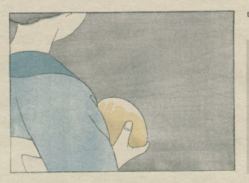What do you see ...?
Last week, I spoke about visiting an exhibition of
'ukiyo-e' art in a Harajuku museum, and about how foreign visitors
probably can't understand much of what they see at such an event.
But after I wrote that, I started to think again ... What do Japanese
visitors see there?
 The Japanese visitors carry in their head quite a
bit of background about the 'world' that was on display in the
exhibition. In school they studied Japanese history, and have a
basic knowledge of the life and times of the Edo-era represented in
this art. They have all seen such images many times before, in
books, magazines and even on television. So none of what they see is
strange or 'exotic' to them.
The Japanese visitors carry in their head quite a
bit of background about the 'world' that was on display in the
exhibition. In school they studied Japanese history, and have a
basic knowledge of the life and times of the Edo-era represented in
this art. They have all seen such images many times before, in
books, magazines and even on television. So none of what they see is
strange or 'exotic' to them.
Being at the exhibition with Sadako gave me a
chance to observe at first hand what the average Japanese person sees
there. When talking to me about the pictures, she mentioned a number
of things that I hadn't particularly noticed. The use of different
brush strokes was one of these. Some pictures had clearly defined
strokes, while others were more vague and blurry. With her knowledge
of calligraphy and the 'fude', it was natural for her to see this.
While looking at one picture, she pointed out to me the many shades
of blue that were used, with the blue pigment being mixed with sumi
to give various grey tones. In yet another place, she laughed about
the 'humour' of the illustration.
All these things had passed unnoticed by me. But
some knowledge of both the techniques involved, and the subject
matter, gives the Japanese viewer a better perspective of such an
exhibition. Of course, we can't understand any art without knowledge
of the culture behind it.
I wonder now - what do Japanese visitors see in
the 'Louvre' in Paris?
 The Japanese visitors carry in their head quite a
bit of background about the 'world' that was on display in the
exhibition. In school they studied Japanese history, and have a
basic knowledge of the life and times of the Edo-era represented in
this art. They have all seen such images many times before, in
books, magazines and even on television. So none of what they see is
strange or 'exotic' to them.
The Japanese visitors carry in their head quite a
bit of background about the 'world' that was on display in the
exhibition. In school they studied Japanese history, and have a
basic knowledge of the life and times of the Edo-era represented in
this art. They have all seen such images many times before, in
books, magazines and even on television. So none of what they see is
strange or 'exotic' to them.